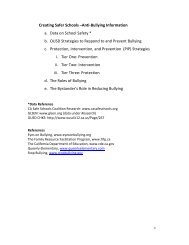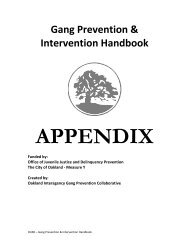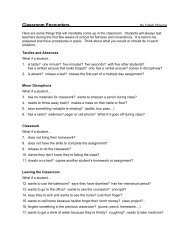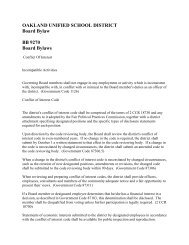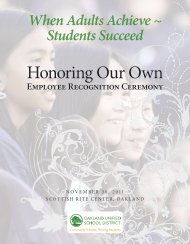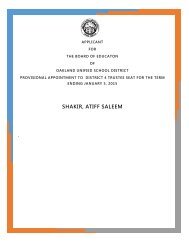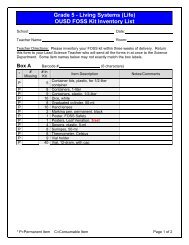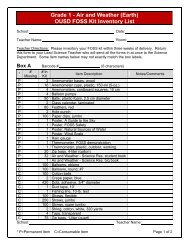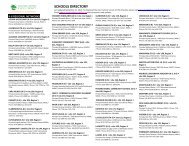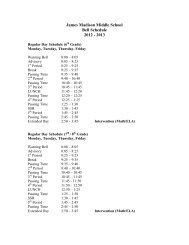Oakland Unified School District Case Study
Oakland Unified School District Case Study
Oakland Unified School District Case Study
Create successful ePaper yourself
Turn your PDF publications into a flip-book with our unique Google optimized e-Paper software.
competing visions, created considerable upheaval,<br />
which the first principal was unable to<br />
overcome.<br />
The school’s second principal, Helen Duffy,<br />
was an experienced principal from the San<br />
Francisco <strong>Unified</strong> <strong>School</strong> <strong>District</strong> and had<br />
worked with ACORN, although she was<br />
new to this East <strong>Oakland</strong> neighborhood. She<br />
brought stability to AWE and mentored Kean<br />
over the next 4 years. In 2004, Duffy announced<br />
her pending retirement and agreed<br />
to stay until Kean finished her administrative<br />
certification program. Kean received a fellowship<br />
to participate in the New Leaders for<br />
New <strong>School</strong>s certification program, which<br />
she credits as playing an essential role in her<br />
development as principal. After her residency<br />
year in 2004-05, she assumed the principalship<br />
for the 2005-06 school year, with the<br />
promise of three more years of leadership<br />
support and coaching from New Leaders for<br />
New <strong>School</strong>s.<br />
The story of Kean’s rise to the principalship<br />
is widely known throughout the school. Kean<br />
grew up in <strong>Oakland</strong> and dropped out of Skyline<br />
High <strong>School</strong> at age 15. After a few years<br />
of renting an apartment with friends and<br />
working at a delicatessen, she completed her<br />
high school equivalency diploma and enrolled<br />
at Laney Community College. She transferred<br />
to the University of California, Berkeley, and<br />
later earned her master’s degree and teaching<br />
certificate at Columbia University’s Teachers<br />
College. After working as a student teacher at<br />
a school in New York that had converted to a<br />
small school, Kean returned to <strong>Oakland</strong> as a<br />
first-year teacher at ACORN Woodland<br />
Elementary 11 . Prior to naming Kean principal,<br />
Helen Duffy created a coaching position<br />
that allowed Kean to visit different schools<br />
and look at the different programs throughout<br />
the district. This process informed Kean’s<br />
subsequent decision to pursue a school revisioning<br />
process (to create a new vision,<br />
mission, and theory of action for the whole<br />
school), focused primarily on developing<br />
the school’s instructional program.<br />
Academic issues, accompanied by a troublesome<br />
school climate, sparked the decision<br />
to place the school on a path toward reincubation.<br />
In 2004-05, Kean was allowed<br />
to join the district’s new school incubator<br />
program, and led the school through the revisioning<br />
process. She described the OUSD<br />
incubator as “what should happen to all<br />
schools first.”<br />
The program was built on a 12-part curriculum<br />
designed by the OUSD New <strong>School</strong><br />
Development Group. The process began by<br />
forming a community-based design team,<br />
creating a school vision and culture, and<br />
then developing a strategy for improving<br />
student outcomes. After those areas had<br />
been addressed, the design team of teachers<br />
and parents worked on developing an<br />
aligned instructional program and implementation<br />
plan. As part of the reincubation,<br />
Kean toured other schools with AWE<br />
family members, and these observers began<br />
to generate a list of ideas they saw at other<br />
schools that they wanted implemented at<br />
AWE. Kean also wrote grants that brought<br />
in approximately $200,000 in additional<br />
funding to provide coaches for leaders and<br />
staff to guide them as they underwent the<br />
change process. Kean sees the re-visioning<br />
process as supporting the school in developing<br />
four key areas: the school’s instructional<br />
program, its academic goals for students,<br />
its school culture, and its vision for family<br />
partnerships. According to Kean, the school<br />
is beginning to see progress in achieving its<br />
vision in each of these respective areas. She<br />
says, “After 3 years, I see substantial evidence<br />
that we are realizing what we set out<br />
to do.”<br />
6<br />
<strong>School</strong> Redesign Network at Stanford University



